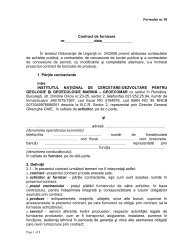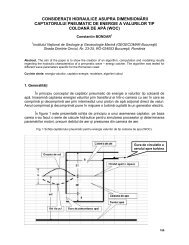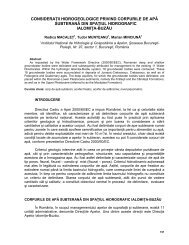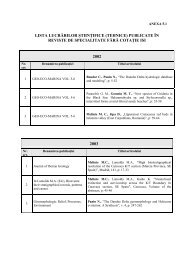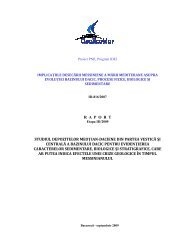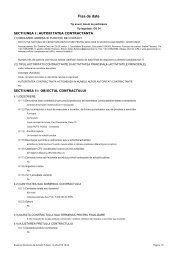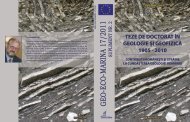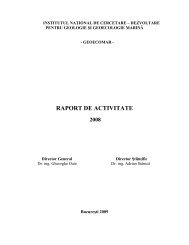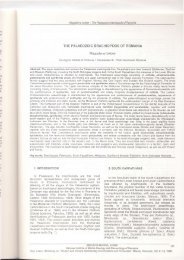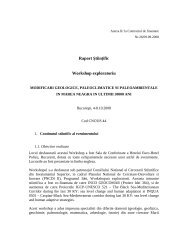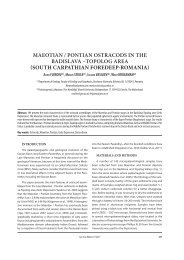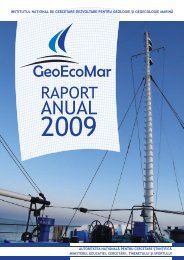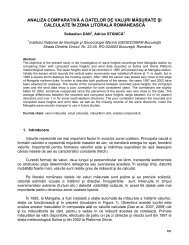LONGSHORE SEDIMENT RANSPORT PATTERN ... - GeoEcoMar
LONGSHORE SEDIMENT RANSPORT PATTERN ... - GeoEcoMar
LONGSHORE SEDIMENT RANSPORT PATTERN ... - GeoEcoMar
You also want an ePaper? Increase the reach of your titles
YUMPU automatically turns print PDFs into web optimized ePapers that Google loves.
L. Giosan et al. - Longshore Sediment Transport Pattem along Romanian Danube Delta Coast<br />
direction is also a direct indicator of the net<br />
longshore transport rate. By using previously<br />
estimated shoaling rates to 9 m depth (Bondar et<br />
al., 1983), the transport is directed southward at a<br />
rate of about 1,080,000 m'/year. Farther south<br />
along Chituc spit, Bondar et al. (1980) estimated<br />
the longshore transport by using synoptic wind<br />
data. The drift was directed southward at a rate of<br />
about 900,000-1,110,000 m3lyear down to the 9 m<br />
isobath.<br />
METHODS<br />
Sediment Budget<br />
A sand budget was used to estimate of the<br />
longshore sediment transport pattern. The active<br />
beach, the longshore transport, and the river<br />
sediment input were assumed to be the only<br />
sources or sinks for sediments for the entire study<br />
area. The above assumptions, however, would not<br />
be valid along barrier beach of Sakhalin the island,<br />
since the cross-shore sedimentation by ovenirrash<br />
and breaching (Panin et al., 1979-1994), and<br />
possibly offshore loss (Bondar et al., 1984; Jianu<br />
and Selariu, 1970) are likely to be important. The<br />
calculations therefore were not done for Sakhalin<br />
island but special consideration was given to the<br />
budget here.<br />
Fig.6 Consecutive posiiions of Sacalin barrier island<br />
(compiled from Breier and Teodor; 1979, Gdstescu, 1979; and<br />
The remaining study area was divided into two<br />
coastal cells based on the changes of the<br />
longshore transport direction and on Danube<br />
Panin et al., 1994).<br />
distributaries sediment discharge. The northern<br />
extremely high. From north to south, the sediment<br />
drift is directed southward along Chilia lobe, shows<br />
a reversal south of Sulina jetties, and continues<br />
cell was taken between Sulina mouth and SfAntu<br />
Gheorghe mouth. The Sulina mouth jetties were<br />
considered to be impermeable to sediment<br />
southward to Midia afterwards. Shuisky (1984) transport because they extend almost to the<br />
estimated the net sediment transport along Chilia estimated depth of closure. Thus the northern<br />
delta to be between 120,000 m'/year and 850,000 lateral boundary for this cell was considered<br />
mt/year, depending on the local orientation of the closed, while the southern one was left open. lt is<br />
coast. The southward drift along Chilia can be reasonable to assume that the Sf6ntu Gheorghe<br />
estimated from the shoaling rates on northern side<br />
of Sulina jetties. Bondar and Harabagiu (1992)<br />
proposed a^ value between 1 ,100,000 and<br />
1,900,000 m'/year for the shoaling rate but the<br />
perimeter for which it was calculated is not clearly<br />
distributary sediment discharge is largely directed<br />
to the south, in such a way there was no significant<br />
contribution from this source to the northern<br />
Sulina-Sfdntu Gheorghe cell. The southem cell<br />
was between Ciotica, situated on the deltaic<br />
specified. Thg shoaling rate of 500,000 m3/year to mainland shore, and Midia. The southern lateral<br />
1,300,000 m'/year (Bondar and Harabagiu, 1992)<br />
on the southern side of the jetties is a direct<br />
boundary was assumed to be closed because the<br />
jetties protecting Midia harbour disrupt the<br />
estimate of the net longshore transport in the longshore sediment transport by redirecting it<br />
reversal zone south of Sulina. The natural shoaling<br />
in this area was clearly overestimated since an<br />
offshore. The northern boundary of this cell was<br />
left open. Net longshore transport patterns for each<br />
unknown but substantial amount of sand retrieved cell were derived from the calculated volume<br />
from Sulina harbour was discharged on the beach changes by integrating them starting at the closed<br />
in 1980s. South of the reversal zone to SfAntu boundaries.<br />
Gheorghe,^the longshore drift was estimated to<br />
700,000 m'/year (Panin et al., 1979-1994) from the<br />
beach sand deficit. Shuisky (1985) suggested a<br />
net longshore sediment transport of 800,000-<br />
900,000 m'/year along the same sector. The<br />
Sakhalin barrier island platform building in the axial<br />
The active beach volume changes were<br />
calculated based on shoreline change rates for the<br />
period between 1962 and 1987 (Vespremeanu and<br />
Stefanescu, 1988; Fig.2 and Fig.3). Because these<br />
data do not extend as farther south as Midia<br />
harbour, the shoreline progradation rate was<br />
GEO.ECO.MARINA, A1997<br />
National lnstitute of Marine Geolagy and Geo-ecology of Romania<br />
Proc. lntern. Workshop on 'Fluvial-Marine<br />
lnteractions" in Malnas, Romania, Oct.1-7, 1996



